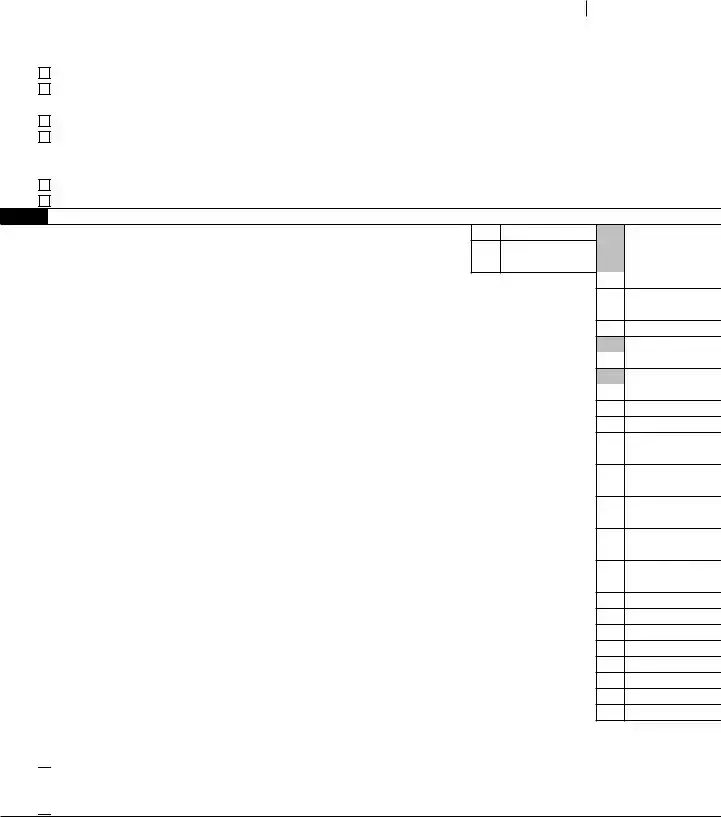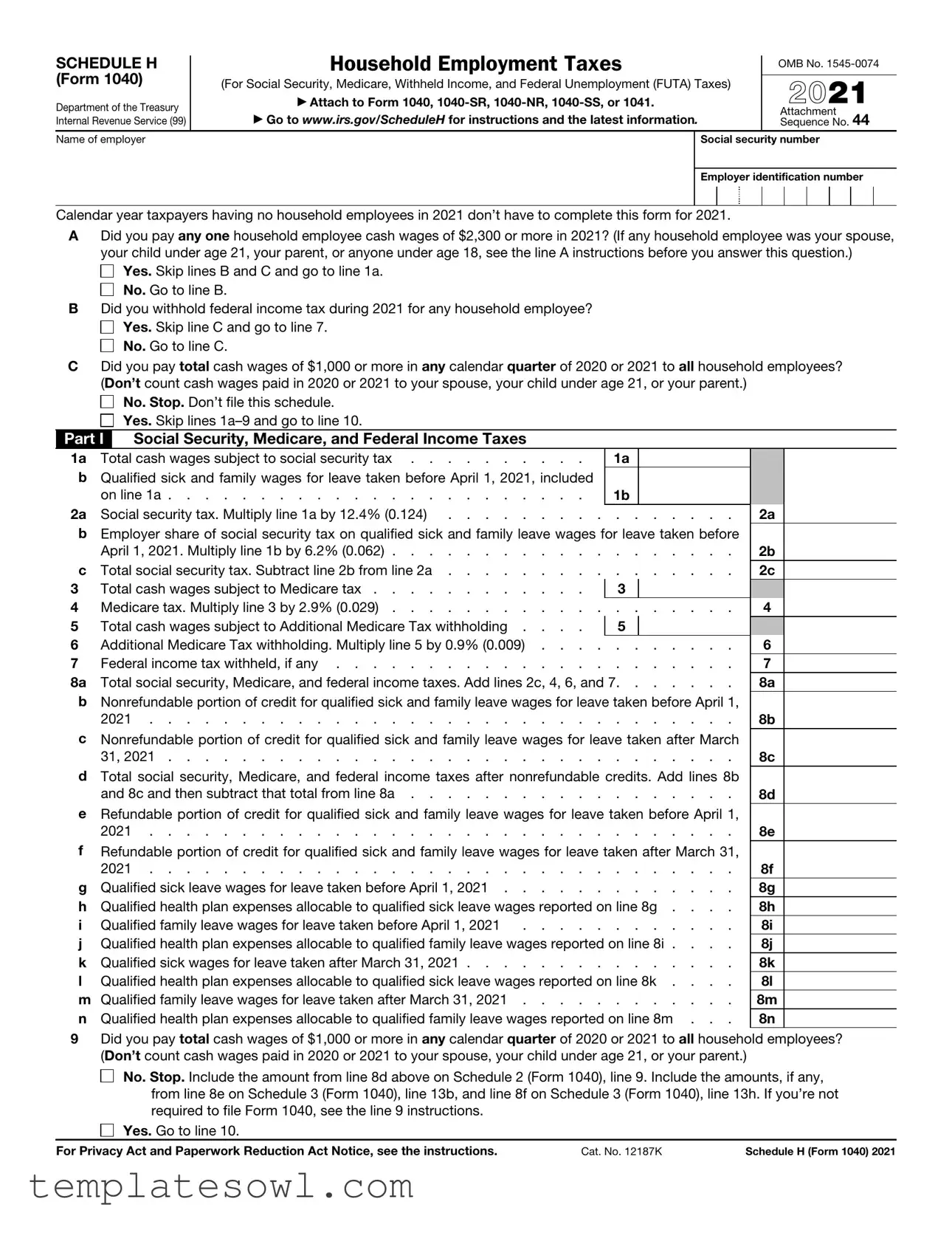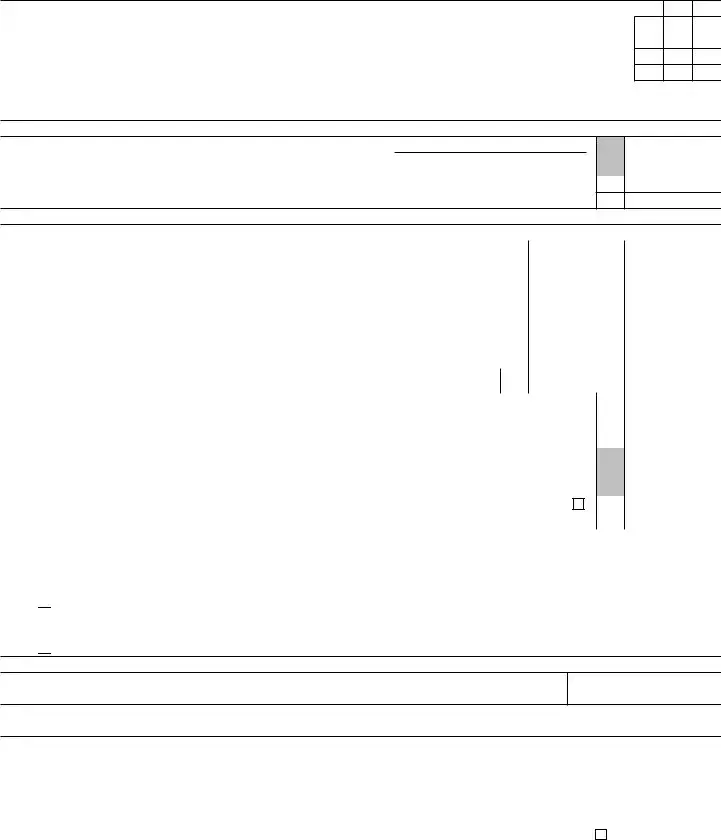
SCHEDULE H |
|
Household Employment Taxes |
|
|
OMB No. 1545-0074 |
|
|
|
(Form 1040) |
|
|
|
|
|
|
|
|
|
|
|
|
|
|
|
|
(For Social Security, Medicare, Withheld Income, and Federal Unemployment (FUTA) Taxes) |
2021 |
|
Department of the Treasury |
|
▶ Attach to Form 1040, 1040-SR, 1040-NR, 1040-SS, or 1041. |
|
|
|
|
|
▶ Go to www.irs.gov/ScheduleH for instructions and the latest information. |
|
|
Attachment |
Internal Revenue Service (99) |
|
|
|
Sequence No. 44 |
Name of employer |
|
|
|
Social security number |
|
|
|
|
|
|
|
|
|
|
|
|
|
|
|
|
Employer identification number |
|
|
|
|
|
|
|
|
|
|
|
|
|
|
|
|
|
|
|
|
|
|
|
|
Calendar year taxpayers having no household employees in 2021 don’t have to complete this form for 2021.
ADid you pay any one household employee cash wages of $2,300 or more in 2021? (If any household employee was your spouse, your child under age 21, your parent, or anyone under age 18, see the line A instructions before you answer this question.)
Yes. Skip lines B and C and go to line 1a.
No. Go to line B.
BDid you withhold federal income tax during 2021 for any household employee?
Yes. Skip line C and go to line 7.
No. Go to line C.
CDid you pay total cash wages of $1,000 or more in any calendar quarter of 2020 or 2021 to all household employees? (Don’t count cash wages paid in 2020 or 2021 to your spouse, your child under age 21, or your parent.)
No. Stop. Don’t file this schedule.
Yes. Skip lines 1a–9 and go to line 10.
Part I Social Security, Medicare, and Federal Income Taxes
1a Total cash wages subject to social security tax |
1a |
bQualified sick and family wages for leave taken before April 1, 2021, included
2a Social security tax. Multiply line 1a by 12.4% (0.124) . . . . . . . . . . . . . . . .
bEmployer share of social security tax on qualified sick and family leave wages for leave taken before
April 1, 2021. Multiply line 1b by 6.2% (0.062) . . . . . . . . . . . . . . . . . . .
c |
Total social security tax. Subtract line 2b from line 2a |
3 |
Total cash wages subject to Medicare tax |
3 |
|
4 |
Medicare tax. Multiply line 3 by 2.9% (0.029) |
5 |
Total cash wages subject to Additional Medicare Tax withholding . . . . |
5 |
|
6 |
Additional Medicare Tax withholding. Multiply line 5 by 0.9% (0.009) |
7 |
Federal income tax withheld, if any |
8a |
Total social security, Medicare, and federal income taxes. Add lines 2c, 4, 6, and 7 |
bNonrefundable portion of credit for qualified sick and family leave wages for leave taken before April 1,
2021 . . . . . . . . . . . . . . . . . . . . . . . . . . . . . . . .
cNonrefundable portion of credit for qualified sick and family leave wages for leave taken after March
31, 2021 . . . . . . . . . . . . . . . . . . . . . . . . . . . . . . .
dTotal social security, Medicare, and federal income taxes after nonrefundable credits. Add lines 8b
and 8c and then subtract that total from line 8a . . . . . . . . . . . . . . . . . .
eRefundable portion of credit for qualified sick and family leave wages for leave taken before April 1,
2021 . . . . . . . . . . . . . . . . . . . . . . . . . . . . . . . .
fRefundable portion of credit for qualified sick and family leave wages for leave taken after March 31,
2021 . . . . . . . . . . . . . . . . . . . . . . . . . . . . . . . .
g |
Qualified sick leave wages for leave taken before April 1, 2021 |
h |
Qualified health plan expenses allocable to qualified sick leave wages reported on line 8g . . . . |
i |
Qualified family leave wages for leave taken before April 1, 2021 |
jQualified health plan expenses allocable to qualified family leave wages reported on line 8i . . . .
k |
Qualified sick wages for leave taken after March 31, 2021 |
l |
Qualified health plan expenses allocable to qualified sick leave wages reported on line 8k . . . . |
m |
Qualified family leave wages for leave taken after March 31, 2021 |
n |
Qualified health plan expenses allocable to qualified family leave wages reported on line 8m . . . |
2a
2b
2c
4
6
7
8a
8b
8c
8d
8e
8f
8g
8h
8i
8j
8k
8l
8m
8n
9Did you pay total cash wages of $1,000 or more in any calendar quarter of 2020 or 2021 to all household employees? (Don’t count cash wages paid in 2020 or 2021 to your spouse, your child under age 21, or your parent.)

 No. Stop. Include the amount from line 8d above on Schedule 2 (Form 1040), line 9. Include the amounts, if any, from line 8e on Schedule 3 (Form 1040), line 13b, and line 8f on Schedule 3 (Form 1040), line 13h. If you’re not required to file Form 1040, see the line 9 instructions.
No. Stop. Include the amount from line 8d above on Schedule 2 (Form 1040), line 9. Include the amounts, if any, from line 8e on Schedule 3 (Form 1040), line 13b, and line 8f on Schedule 3 (Form 1040), line 13h. If you’re not required to file Form 1040, see the line 9 instructions.

 Yes. Go to line 10.
Yes. Go to line 10.
For Privacy Act and Paperwork Reduction Act Notice, see the instructions. |
Cat. No. 12187K |
Schedule H (Form 1040) 2021 |
Schedule H (Form 1040) 2021 |
Page 2 |
Part II |
Federal Unemployment (FUTA) Tax |
|
10Did you pay unemployment contributions to only one state? If you paid contributions to a credit reduction
state, see instructions and check “No” . . . . . . . . . . . . . . . . . . . . . . .
11Did you pay all state unemployment contributions for 2021 by April 18, 2022? Fiscal year filers, see instructions
12Were all wages that are taxable for FUTA tax also taxable for your state’s unemployment tax? . . . . .
Next: If you checked the “Yes” box on all the lines above, complete Section A.
If you checked the “No” box on any of the lines above, skip Section A and complete Section B.
13Name of the state where you paid unemployment contributions ▶
14 |
Contributions paid to your state unemployment fund |
14 |
|
15 |
Total cash wages subject to FUTA tax |
16 |
FUTA tax. Multiply line 15 by 0.6% (0.006). Enter the result here, skip Section B, and go to line 25 . |
|
Section B |
|
|
17Complete all columns below that apply (if you need more space, see instructions):
(a) |
(b) |
|
(c) |
(d) |
(e) |
(f) |
(g) |
(h) |
Name of state |
Taxable wages |
State experience |
State |
Multiply col. (b) |
Multiply col. (b) |
Subtract col. (f) |
Contributions |
|
(as defined in |
rate period |
experience |
by 0.054 |
by col. (d) |
from col. (e). |
paid to state |
|
state act) |
|
|
|
rate |
|
|
If zero or less, |
unemployment fund |
|
|
From |
|
To |
|
|
|
enter -0-. |
|
|
|
|
|
|
|
|
|
|
|
|
|
|
|
|
|
|
|
|
|
|
|
|
|
|
|
|
|
|
|
18 |
Totals |
. |
. |
18 |
|
|
19 |
Add columns (g) and (h) of line 18 |
|
19 |
|
|
|
|
|
|
|
20 |
Total cash wages subject to FUTA tax (see the line 15 instructions) . . . . |
. |
. . |
. . . . . |
20 |
|
21 |
Multiply line 20 by 6.0% |
(0.06) |
. |
. . |
. . . . . |
21 |
|
22 |
Multiply line 20 by 5.4% |
(0.054) |
|
22 |
|
|
|
23Enter the smaller of line 19 or line 22.
|
|
|
|
|
|
(If you paid state unemployment contributions late or you’re in a credit reduction state, see instructions |
|
|
|
and check here) |
23 |
|
24 |
FUTA tax. Subtract line 23 from line 21. Enter the result here and go to line 25 |
24 |
|
Part III |
Total Household Employment Taxes |
|
|
25 |
Enter the amount from line 8d. If you checked the “Yes” box on line C of page 1, enter -0- . . . . |
25 |
|
26 |
Add line 16 (or line 24) and line 25 |
26 |
|
27Are you required to file Form 1040?
 Yes. Stop. Include the amount from line 26 above on Schedule 2 (Form 1040), line 9. Include the amounts, if any, from line 8e, on Schedule 3 (Form 1040), line 13b, and line 8f on Schedule 3 (Form 1040), line 13h. Don’t complete Part IV below.
Yes. Stop. Include the amount from line 26 above on Schedule 2 (Form 1040), line 9. Include the amounts, if any, from line 8e, on Schedule 3 (Form 1040), line 13b, and line 8f on Schedule 3 (Form 1040), line 13h. Don’t complete Part IV below.
 No. You may have to complete Part IV. See instructions for details.
No. You may have to complete Part IV. See instructions for details.
Part IV Address and Signature — Complete this part only if required. See the line 27 instructions.
Address (number and street) or P.O. box if mail isn’t delivered to street address
City, town or post office, state, and ZIP code
Under penalties of perjury, I declare that I have examined this schedule, including accompanying statements, and to the best of my knowledge and belief, it is true, correct, and complete. No part of any payment made to a state unemployment fund claimed as a credit was, or is to be, deducted from the payments to employees. Declaration of preparer (other than taxpayer) is based on all information of which preparer has any knowledge.
▲ |
|
|
|
▲ |
|
|
|
|
|
Employer’s signature |
|
Date |
|
|
|
|
|
|
|
|
|
|
|
|
|
|
Paid |
Print/Type preparer’s name |
Preparer’s signature |
|
Date |
|
Check |
if |
PTIN |
|
|
|
|
|
|
|
|
|
|
|
|
|
self-employed |
|
Preparer |
|
|
|
|
|
|
|
|
|
|
|
|
|
|
|
|
Firm’s name ▶ |
|
|
|
|
Firm’s EIN ▶ |
|
|
Use Only |
|
|
|
|
|
|
Firm’s address ▶ |
|
|
|
|
Phone no. |
|
|
|
|
|
|
|
|
|
|
Schedule H (Form 1040) 2021








